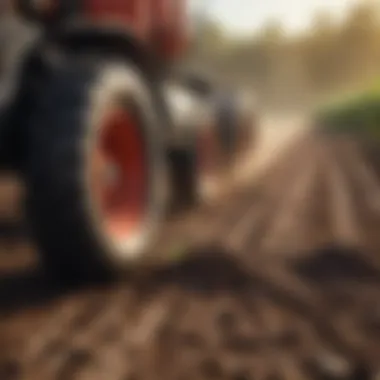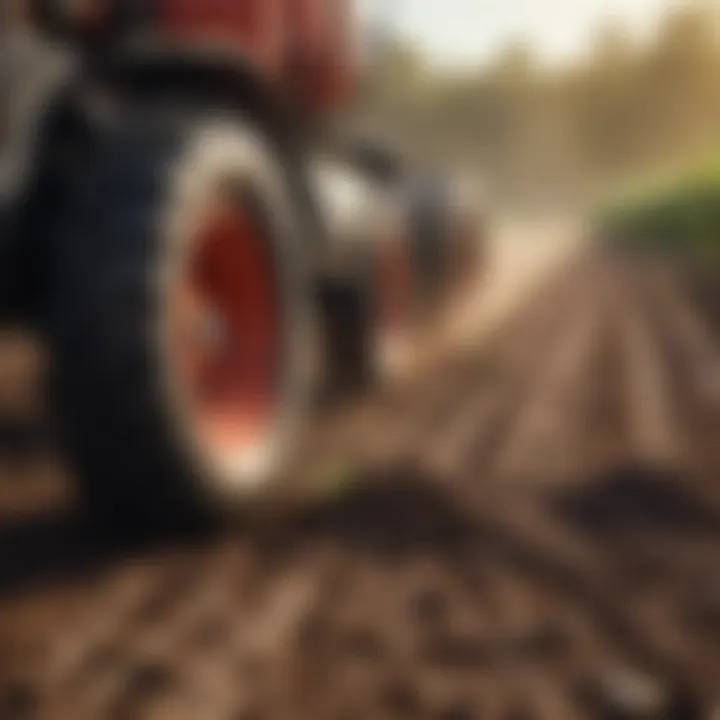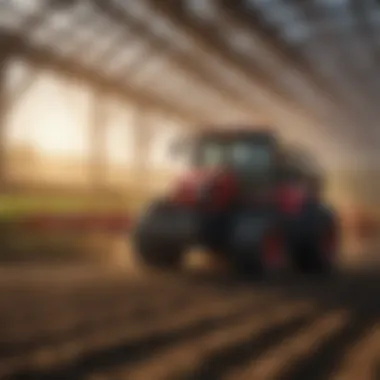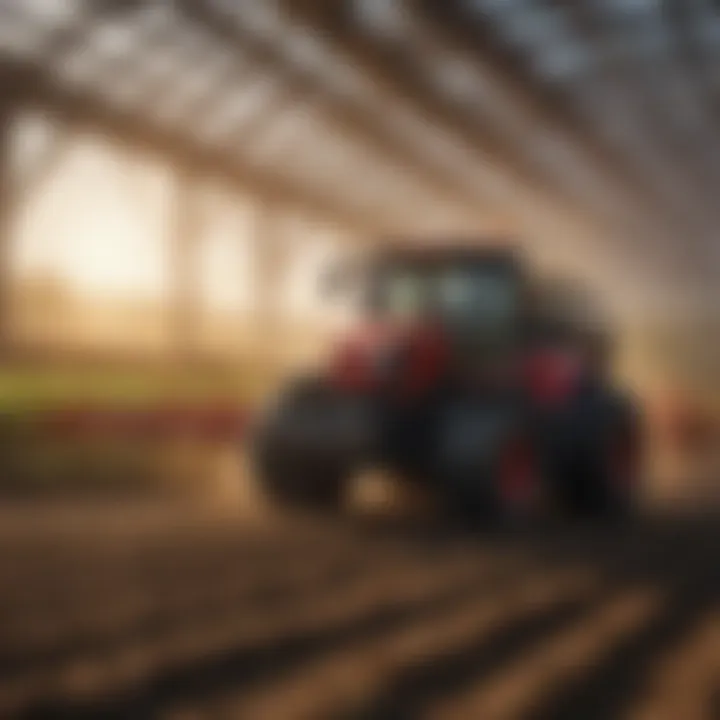Agriculture Meets Technology: A New Era in Farming


Intro
The marriage of agriculture and technology is not just a modern phenomenon; it is a profound rework of how we think about food production and environmental stewardship. Farmers today find themselves at a crossroads, navigating both age-old practices and cutting-edge innovations. Whether through the use of drones for crop monitoring or advanced irrigation systems, it’s clear that technology is revolutionizing farming methods. The challenge lies in understanding the nuances of these changes and adapting to them for a sustainable future.
Topic Overview
Definition and Importance
Agriculture technology, often referred to as AgTech, encompasses a broad range of techniques and tools that are employed to improve the efficiency of farms. This includes everything from robotics to biological advancements. The importance of this intersection cannot be overstated as it plays a crucial role in feeding a growing global population while also addressing pressing environmental concerns. Technology has the potential to mitigate the challenges posed by climate change, such as drought, soil degradation, and pest invasions.
Brief History and Evolution
Agriculture has evolved since the advent of civilization. Early farmers relied on simple tools and practical knowledge passed down through generations. Fast forward to the 20th century, and we see the introduction of mechanization and synthetic fertilizers, which transformed farming into a more industrialized activity. The 21st century brings a wave of digital transformation. From satellite technology to genetic engineering, the innovations continue hitting the fields like showers after a drought.
Key Techniques and Innovations
Sustainable Farming Practices
Sustainability is at the heart of modern agriculture aims. Practices such as crop rotation, organic farming, and permaculture are being enhanced through technology. Consider the use of precision agriculture techniques, which utilize GPS and soil sensors. These technologies enable farmers to determine the exact needs of their crops—reducing the overuse of fertilizers and conserving water resources.
Key Highlights:
- Precision farming: Enables targeted use of inputs.
- Vertical farming: Maximizes space utilization
- Aquaponics: Combines fish farming with plant cultivation
Advanced Agronomic Technologies
The deployment of drones and AI is reshaping data collection and analysis in farming. These innovations promise not just improved yields but also better resource management. For example, a farmer using drones can quickly assess crop health across vast fields much faster than traditional methods.
Practical Applications
Step-by-Step Guides
Implementing these technologies requires a careful, strategic approach. Here’s a simple guide to embracing AgTech:
- Identify Needs: Assess the specific challenges your farm faces.
- Research Solutions: Look into various technologies available.
- Pilot Testing: Start small. Test innovations on a limited scale.
- Measure Results: Assess the effectiveness of implementations.
- Scale Up: Once confident, roll out initiatives across larger areas.
Case Studies or Real-World Examples
One notable example is the use of smart irrigation systems. These systems utilize real-time data to adjust water delivery based on weather forecasts, soil moisture levels, and plant needs. Farmers have reported up to a 30% reduction in water usage while maintaining crop productivity. Such practical applications demonstrate the tangible benefits of technology in agriculture.
Technology in agriculture is not just about machines; it’s about enhancing life, productivity, and sustainability in a holistic manner.
This evolving landscape of agriculture and technology is not just an improvement of what's been done in the past. It is a new way of thinking about how we cultivate, manage, and work with the land. Keeping an eye on these developments is essential for farmers, agribusinesses, and policymakers aiming to navigate these uncharted waters.
Prelims to Agricultural Technology
Agricultural technology plays a pivotal role in modern farming, shaping the ways farmers enhance productivity while also addressing sustainability challenges. By integrating technology into agriculture, one does not merely modernize traditional practices; instead, one redefines the very framework upon which agriculture stands. This intersection of tech and agri fosters innovative solutions that bridge gaps between age-old farming wisdom and cutting-edge innovation.
As agricultural enthusiasts, understanding this blend of technology empowers farmers to optimize operations, improve crop yields, and contribute to environmental well-being. In today’s fast-paced world, adopting new agricultural methods is not just a luxury but a necessity. Farmers are realizing the benefits that precision agriculture, robotics, and biotechnology bring into their fields.
Defining Agricultural Technology
Agricultural technology encompasses a broad spectrum of tools and processes designed to augment farming efficiency. It includes everything from machinery – like tractors that can navigate fields autonomously – to advanced data analytics that predict weather patterns and optimize irrigation. But beyond machinery, it also encompasses genetic modification methods that prepare crops to withstand pests or extreme conditions.
In essence, agricultural technology is about leveraging scientific and engineering principles to make farming smarter. For example, using IoT (Internet of Things) devices allows farmers to track soil moisture levels in real time, ensuring that crops receive adequate water without waste. This intersection, quite dramatically, illustrates how technology transforms fundamental practices of growing food.
Historical Evolution of Agricultural Practices
If we turn back the clock, we find that agriculture has always adapted to changing circumstances. In ancient times, farmers relied on manual labor and rudimentary tools, such as wooden plows, which were a significant leap forward from just tilling the earth with sticks. Fast forward a few centuries, and we find the introduction of irrigation systems, which revolutionized crop production by controlling water supply.
As time marched on, so did advancements. The Industrial Revolution ushered in mechanization of farming, making it possible to cultivate larger areas with less human labor. The rise of hybrid seeds and fertilizer in the mid-20th century set new benchmarks for crop yields.
Today, new technologies are evolving so fast that continuous learning is necessary. Drones are now flying over fields, capturing data that was previously measured by hand.


"Each advance in agricultural technology has propelled the sector forward, while also requiring farmers to adjust to new challenges and opportunities."
To summarize, understanding the historical context of agricultural technology enlightens us on how much progress has been made. It shows that embracing innovation has been fundamental to agriculture's survival through millennia.
This backdrop sets the stage for examining the current technologies transforming agriculture today. As we explore the modern tools at farmers' disposal, it becomes clear that agriculture is in the midst of yet another paradigm shift, one that is critically important for sustainability and productivity.
Types of Agricultural Technology
Agricultural technology has come a long way. It lays the groundwork for modern farming practices. These innovations not only enhance productivity but also strive to meet the global food demand in a sustainable manner. Understanding different types of agricultural technologies is paramount. Each type offers unique benefits and considerations that help shape the future of farming.
Precision Agriculture
Precision agriculture stands out as a beacon of efficiency in modern farming. This approach uses data collected from various sources like satellites, sensors, and drones to optimize crop production. By leveraging this data, farmers can monitor field variability and adjust practices accordingly. It’s like having a crystal ball that informs farmers about when to water, fertilize, or harvest.
Benefits of precision agriculture include:
- Increased yields: Tailored interventions can lead to greater outputs.
- Resource management: More efficient use of water and fertilizers reduces costs and environmental impact.
- Real-time data insights: Farmers can make informed decisions quickly.
However, it is not all roses. Getting started with precision agriculture can require a hefty investment and expertise which some farmers might lack.
Biotechnology in Farming
Biotechnology brings a scientific edge to the age-old practice of farming. Techniques such as genetic modification and tissue culture enhance the resilience and yield of crops. For instance, biotechnology has helped develop pest-resistant species that require less pesticide. This can be a game changer for farmers battling infestations.
Key aspects of biotechnology in agriculture include:
- Improved crop resilience: Crops can withstand harsh weather conditions.
- Enhanced nutritional content: Modifications can fortify crops with essential vitamins.
- Sustainable farming: Reductions in chemical usage promote ecosystem health.
Despite these advances, biotech may meet resistance from consumers concerned about GMOs. Transparency and education are crucial for wider acceptance.
Automated Systems and Robotics
Automation has seeped into every corner of agriculture. Automated systems and robotics streamline various tasks, from planting to harvest. For example, robotic harvesters can pick fruits with precision, reducing the need for manual labor. This technology not only saves time but also minimizes the risk of human error.
Considerations for using automated systems include:
- Labor shortages: These systems fill the gap where there aren’t enough workers.
- Operational efficiency: Automation often speeds up the workflow.
- Cost efficiency: Although initial costs may be high, long-term savings can be substantial.
However, the upfront investment can be intimidating, especially for small-scale farmers.
Aerial Imaging and Drones
Aerial imaging and drone technology add a new dimension to agricultural monitoring. Drones can capture high-resolution images of fields, allowing farmers to assess crop health and identify issues like disease or nutrient deficiency before they escalate. It’s as if farms are viewed from the eyes of an eagle – giving a sweeping perspective that can enhance decision-making.
Benefits of drones include:
- Efficient monitoring: Cover large areas quickly and accurately.
- Variable rate application: They can help in precise application of inputs.
- Cost-effective: Reduces the need for expensive equipment like planes or helicopters.
Drones may face regulatory challenges and require some pilot training, but their potential is clear.
Farm Management Software
Farm management software (FMS) serves as the nerve center for modern agricultural operations. These platforms consolidate data regarding crop management, resource allocation, financials, and more. Farmers can track everything from planting schedules to harvest outcomes within a single interface.
Key features of farm management software include:
- Data analytics: Real-time analysis aids in strategic decision-making.
- Record keeping: Streamlined tracking of practices and inputs boosts compliance.
- Yield forecasting: Anticipating yields helps manage cash flow effectively.
Automation and efficiency are the names of the game here, though the transition can be overwhelming for less tech-savvy individuals.
The evolution of agricultural technology represents a critical shift. Farmers have new tools at their disposal to thrive in an ever-changing landscape. By incorporating these technologies, the farming sector can effectively tackle the complexities of modern agriculture.
With each type of agricultural technology outlined, it becomes evident how these innovations are interlinked, each building on the strengths of the others to drive efficiency and sustainability in farming practices.
Impact of Technology on Crop Production


Agricultural technology has revolutionized how crops are grown, harvested, and managed, wielding significant influence over crop production. This section aims to explore the pivotal role technology plays in enhancing agricultural outputs while addressing some pressing challenges that farmers encounter. Efficient crop production is not just about increasing quantity; it’s about improving quality, sustainability, and adaptability in the face of climate change and resource scarcity.
Enhancing Yield Through Data Analysis
Data analysis is becoming a game changer in agriculture. With the advent of sophisticated data-gathering tools like sensors and satellite imagery, farmers can now collect vast amounts of information about their fields. Here’s how it contributes to better crop yields:
- Real-Time Decision Making: Farmers can assess real-time data on soil moisture, temperature, and nutrient levels, allowing for quick adjustments to their practices.
- Predictive Analytics: By employing algorithms and forecasting models, farmers can predict yield outcomes based on various conditions such as weather patterns or pest invasions.
- Crop Rotation Optimization: Analyzing past data helps farmers figure out which crops prosper in specific sequences, promoting biodiversity and improving soil health.
The application of data analysis is transformative. By implementing it, farmers often see a noticeable uptick in yield. For example, those who utilized precision farming techniques, which hinge on data, reported increases in productivity of up to 30%. As farming becomes more data-driven, the reliance on intuitive judgment decreases, leading to smarter decisions and ultimately higher yields.
Soil Management Technologies
Healthy soil is the cornerstone of successful farming, and technology is stepping in to ensure that our soils are treated with the care they deserve. Soil management technologies, such as precision soil testing and GPS-based soil mapping, help farmers understand the unique needs of their land. Here are some key benefits:
- Tailored Fertilization: By analyzing soil composition, farmers can apply fertilizers in specific areas rather than globally over the field. This not only improves crop health but cuts down on excess chemicals that can harm the environment.
- Enhanced Soil Structure: Technologies that monitor soil moisture levels ensure that it retains the right amount of water, which is crucial during drought periods.
- Preventative Measures Against Erosion: Soil erosion can cripple productivity. Modern techniques utilize cover crops and contour farming, supported by tech, to minimize erosion risks.
"The quality of agriculture is rooted in the vitality of soil. Technologies that enhance this aspect can potentially change productivity indices drastically."
Considering all these developments, it's clear that the impact technology wields over crop production is profound. Not only does it facilitate better yield, but it also sets the stage for an agricultural revolution that is conscientious about environmental health and sustainability.
Sustainability and Technology
The intersection of sustainability and technology serves as a pillar for modern agricultural practices. In a time when climate change and resource depletion loom large, it becomes crucial to employ innovative solutions that not only enhance productivity but also ensure environmental balance. The rising awareness regarding sustainable development prompts farmers and agricultural stakeholders to consider practices that protect ecosystems while meeting food production demands.
By integrating technology into sustainable practices, we can achieve several noteworthy benefits:
- Resource Efficiency: Technologies such as precision agriculture utilize data and sensors to optimize inputs like water, fertilizers, and pesticides. This leads to better crop yields with minimal wastage.
- Biodiversity Conservation: Sustainable farming practices supported by technology help in maintaining biodiversity. For example, tools that monitor soil health can facilitate crop rotations and mixed farming, naturally building resilience against pests.
- Social Responsibility: Utilizing technology to advance sustainability can also enhance a farm's reputation among consumers who are increasingly favoring ethically sourced products.
In summary, the amalgamation of sustainability and technology not only addresses immediate agricultural challenges but also secures long-term prosperity for future generations.
Sustainable Farming Practices
Sustainable farming practices are rooted in the principles of ecological balance. They focus on reducing dependency on chemical inputs and fostering a healthy agroecosystem. These practices often encompass various strategies, including crop rotation, cover cropping, and integrated pest management. Take organic farming, for example. It emphasizes the use of natural fertilizers and pest control methods, thus minimizing chemical residues in the environment while promoting soil health.
Moreover, technology has played a pivotal role in enhancing these sustainable methods. The advent of farm management software now allows farmers to keep track of their practices in real-time. By documenting and analyzing data on crop performance, farmers can make informed decisions that align with sustainability goals.
Reducing Environmental Impact
The environmental impact of traditional farming is often significant, contributing to soil degradation and water pollution. However, technology can reduce this impact substantially. For instance, technologies like variable rate technology (VRT) allow for targeted application of inputs, ensuring that only the necessary amount is used. This ultimately reduces leaching and runoff, protecting water bodies from excess nutrients.
In addition, implementing precision irrigation systems aids in minimizing water usage by delivering moisture directly to plant roots. Such systems can adjust water application based on soil moisture levels, making them particularly effective in regions facing drought.
"Incorporating technology into environmentally conscious farming is not just a trend; it's a necessity for balancing productivity with ecological integrity."
Water Management Innovations
Water management stands at the forefront of sustainable agricultural practices. Innovative technologies like drip irrigation and soil moisture sensors have revolutionized how farmers allocate water. Through drip systems, water drips directly to the roots of plants, minimizing evaporation and ensuring efficient use of this invaluable resource.
Soil moisture sensors, on the other hand, allow farmers to gauge the specific water needs of crops at any given moment. By understanding when to irrigate and how much water is necessary, farmers can avoid overwatering and the associated waste.
The rise of rainwater harvesting systems also reflects how technology can aid sustainability. These systems collect and store rainwater for agricultural use, reducing dependency on groundwater and promoting resilience against climate variability.
Challenges and Limitations of Agricultural Technology
In the ever-evolving nexus of agriculture and technology, it's essential to dissect not just the innovations but also the roadblocks that stand in their way. As we zoom in on this sector, the gaps and hurdles become glaringly apparent, revealing complexities that can easily be overlooked. Understanding these challenges enables stakeholders—be they farmers, policymakers, or technologists—to forge paths that truly enhance agricultural practices rather than merely adding layers of complexity.
Financial Barriers for Farmers
One of the most daunting impediments facing farmers today lies in the financial realm. Investing in cutting-edge technology often comes with steep upfront costs. Whether it's precision agriculture tools or sophisticated farm management software, the expenses can pile up faster than the harvest if one isn’t careful. For smaller farms especially, these costs can be prohibitive. Imagine a farmer, already feeling the pinch from fluctuating market prices, trying to navigate the hefty price tags of new machinery or software systems.
Moreover, the lack of access to credit can further exacerbate this issue. Farmers looking to adopt new technologies may find themselves stuck in a quagmire, unable to secure loans or financial assistance. Even with options like government grants or subsidies, the application processes can be daunting and often complex. As a result, some farmers might feel hesitant to take the plunge, missing out on innovations that could potentially increase their yield and productivity.
Many innovative technologies are simply out of reach for a significant portion of farms, especially smaller operations.


Technological Access and Literacy Issues
Access to technology is another significant hurdle. In many rural regions, high-speed internet remains a luxury rather than a standard. A farmer's ability to use farm management software, employ drones for aerial imaging, or participate in online agricultural communities can be drastically hampered by connectivity issues. Without reliable internet access, the digital revolution in farming seems far more like a distant dream.
Equally important is the concept of technological literacy. Even when access isn't an issue, the questions arise: Who will train the farmers to utilize these advanced tools? Without proper training, the best technology is just expensive machinery sitting idle in the barn. In many cases, older generations of farmers might have reservations about embracing new tech, feeling more comfortable with traditional methods. The knowledge gap here is a serious concern, underscoring the necessity for education and training programs that can ease this transition.
When these issues are combined, it's clear that the challenges of financial barriers along with accessibility and literacy can't be brushed aside. Addressing these elements through targeted initiatives and policies is of utmost importance to ensure that the agricultural sector reaps the full benefits of technological advancements.
Future Trends in Agricultural Technology
In this age where technology is intertwined with numerous sectors, agriculture is not lagging behind. The future of farming hinges on the innovative technologies that are emerging on the horizon. These advancements not only streamline farming practices but also tackle the significant challenges that farmers face today, such as climate change, resource scarcity, and the need for increased production. Understanding these trends is essential for any farmer or enthusiast who's keen on ensuring that agriculture evolves sustainably and effectively.
Emerging Technologies to Watch
The next wave of agricultural technology is unfolding, and it warrants attention. Here are some of the most promising technologies:
- Vertical Farming: This method allows crops to be grown in stacked layers, using significantly less land and water compared to traditional farming. By incorporating LED lighting and climate control, vertical farms can produce fresh food year-round regardless of external weather conditions.
- Smart Irrigation Systems: Advanced sensors and data-driven approaches to irrigation are gaining ground. These systems ensure that crops receive the right amount of water, which not only conserves water but promotes healthier plant growth. Farmers can save resources while maximizing yields.
- Gene Editing: Innovations like CRISPR are revolutionizing how crops are developed. By editing specific genes, farmers can create strains that are more resistant to pests, diseases, and climate variations. This technology holds the potential to improve food security around the world.
"The intersection of agriculture and technology foretells a transformation that will not only yield more but do so with greater respect for environmental boundaries."
The Role of Artificial Intelligence
Artificial intelligence (AI) is becoming a game changer in farming operations. By processing vast amounts of data, AI can help farmers make informed decisions. It optimizes planting schedules, improves pest management, and predicts crop yield with remarkable accuracy.
Moreover, machine learning algorithms analyze historical data and real-time insights, offering personalized recommendations for crop care. This tailored approach increases success rates and minimizes waste. For instance, farmers can track the health of plants through AI-powered image analysis, allowing for quick interventions when issues arise. The importance of AI cannot be overstated; it's like having a high-tech advisor who is constantly learning and adapting.
Blockchain Technology in Agriculture
Blockchain is often associated with cryptocurrencies, but its potential in agriculture is significant as well. This technology ensures transparency and traceability in the food supply chain. For farmers, this means that the journey from farm to table can be documented and verified.
- Traceability: With blockchain’s immutable ledgers, consumers can trace the origin of their food, ensuring it meets safety and quality standards. This builds trust and enhances the farmer’s brand.
- Smart Contracts: Farmers can use smart contracts to automate transactions, reducing the need for intermediaries. This can lower costs and make trading more efficient. For example, payments can be executed automatically once the terms of an agreement are met, ensuring that farmers get their dues promptly.
- Supply Chain Management: Utilizing blockchain facilitates better coordination along the supply chain, leading to reduced waste and optimized production.
As agriculture moves toward a more digitized future, these technologies will play a critical role in shaping practices that are not only efficient but also sustainable.
Case Studies in Agricultural Technology
When delving into the intricate relationship between agriculture and technology, examining concrete examples is of utmost importance. Case studies in agricultural technology not only highlight the innovations that have successfully transformed farming practices but also illustrate the pitfalls that can arise from poorly executed technological implementations. These real-world instances provide valuable insights into how technology can bolster productivity and sustainability in agriculture, while also serving as cautionary tales for future endeavors.
Successful Implementations Around the Globe
Numerous success stories in agricultural technology demonstrate how innovative practices can significantly enhance crop yields, improve operational efficiency, and promote environmental sustainability. For instance, countries such as Israel have pioneered the use of drip irrigation technology, which conserves water while maximizing crop growth. This method has revolutionized farming in arid regions, allowing for higher levels of production from less water—something critical as climate change continues to strain water resources worldwide.
Another compelling case is that of vertical farming technologies applied in urban settings like Singapore. Here, companies like Sky Greens have adopted hydroponics and aeroponics to grow produce without soil. These systems utilize controlled environments, which significantly reduce the need for pesticides and fertilizers, ensuring cleaner and healthier produce for urban populations. The benefits in terms of space efficiency, reduced transportation emissions, and minimal water use cannot be overstated.
"By harnessing technology in agriculture, we unlock new dimensions for food production that were once thought impossible." – Agricultural Innovator
Lessons Learned from Failed Innovations
However, not every technological intervention has led to success. Understanding the lessons from failed innovations is equally critical. One notorious example includes the introduction of genetically modified crops that were supposed to be pest-resistant. The initial excitement fizzled out when over-reliance on a single glyphosate herbicide led to widespread resistance among weeds, resulting in a cascade of increased herbicide use and an environmental crisis.
Moreover, implementations of robotic farming solutions have seen mixed results. While some farmers celebrated the efficiency brought by these machines, others faced disappointing returns on investment. Many found the integration of robotics to be too costly and complicated, particularly for small-scale farms with limited resources. This highlighted the necessity for indeed adapting technologies to various scales of farming, ensuring affordability and accessibility for all.
In the end, examining these case studies is vital for anyone engaged in the agricultural sector. They not only highlight successful technologies but also illuminate the missteps from which future innovations can learn.
End: The Future of Agriculture in a Technological Age
In contemplating the future of agriculture, it's pivotal to recognize how technology stands as a cornerstone shaping every facet of agricultural practice. The relationship between innovative methods and age-old traditions creates a tapestry where efficiency, productivity, and sustainability are interwoven, fundamentally revolutionizing how food is produced. This section elucidates the significance of technology’s role and its implications for modern agriculture.
The Vital Role of Technology in Sustainable Agriculture
Sustainability has increasingly become a buzzword in agricultural circles, but its meaning is multifaceted. Rather than a one-size-fits-all solution, sustainable agriculture represents a holistic approach aiming for environmental integrity, economic profitability, and social equity. Here, technology plays a vital role through several avenues.
- Resource Efficiency: Technologies like precision farming ensure that resources are allocated effectively. This means using exactly the right amount of water, fertilizers, and pesticides, reducing wastage and minimizing environmental impacts.
- Data-Driven Decisions: By harnessing data analytics, farmers can make informed choices tailored to their land's specific needs. Monitoring variables such as soil health and crop vigor in real time enables farmers to act quickly and reduce chemical usage, aligning with sustainable practices.
- Biodiversity Conservation: Incorporating biotechnology helps enhance crop resilience against pests and diseases, allowing for a more extensive reliance on fewer chemical treatments. It can also play a role in enhancing biodiversity by promoting the use of native plant species.
"Sustainable agriculture is not merely surviving; it's about thriving in harmony with our planet's delicate ecosystems."
Embracing Change for a Resilient Agricultural Landscape
Change often elicits resistance, especially in industries with deep-rooted traditions, such as agriculture. Nonetheless, embracing change is necessary for creating a resilient agricultural landscape capable of withstanding shocks from climate change, economic instability, and shifting market demands.
- Adaptability: Farmers need to remain adaptable. Technological advancements offer tools that help in assessing climatic conditions and adapting crop varieties accordingly. This flexibility is vital in mitigating potential losses from unforeseen environmental challenges.
- Community Engagement: Training and educating farmers about emerging technologies foster community resilience. Leveraging social media forums on platforms like Reddit can help farmers share experiences and solutions in real time, further strengthening community ties and adaptability.
- Economical Solutions: Innovations don’t have to be prohibitively expensive. Many grassroots movements find low-cost technological solutions, thus making agricultural practices more sustainable without straining budgets.



